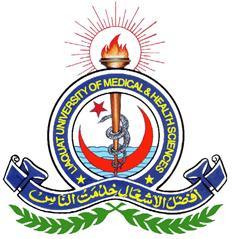Association of the c.75C>A Variant in CLCC1 with Autosomal Recessive Retinitis Pigmentosa in Pakistan
Keywords:
CLCC1 gene, night blindness, endogamous pedigree, genetic counseling, Sanger sequencing, phenotype-genotype correlationAbstract
Objective: To identify the disease-causing allele of retinitis pigmentosa, a heterogeneous genetic disorder in a single affected family.
Methodology: A cross-sectional descriptive study was conducted at the Sindh Institute of Ophthalmology & Visual Sciences Hyderabad from December 2022 to December 2023, with approval from the SIOVS ethical committee. A consanguineous pedigree with multiple affected members was included, while pedigrees with only one affected member or secondary causes of vision loss were excluded. After getting informed consent, each enrolled participant's blood samples (10 cc) were collected, and DNA was extracted. The family was subjected to Sanger sequencing for the CLCC1 gene.
Results: In this study, one reported c.C75A, p.Asp25Glu allele in the CLCC1 gene was identified from an endogamous pedigree in Sindh, Pakistan. The identified c.C75A, p.Asp25Glu allele is a common cause of autosomal recessive retinitis pigmentosa (arRP) in Pakistani-affected individuals. This allele is estimated to have occurred 2000-5000 years ago and has been transmitted to affected individuals of Pakistani origin and global descent across various geographical regions. All the affected patients underwent detailed clinical investigations, including fundus photography and optical coherence tomography, to confirm the retinitis pigmentosa symptoms. The Sanger sequencing method was used to detect pathogenic variants, and bioinformatics tools were utilized to investigate the pathogenesis of identified alleles and compare phenotype-genotype correlations.
Conclusion: The finding of frequent disease-causing alleles from Pakistani-affected patients will significantly improve existing genetic databases and facilitate more accurately the affected diagnosis of gene testing.
References
Karali M, Testa F, Brunetti-Pierri R, Di Iorio V, Pizzo M, Melillo P et al. Clinical and Genetic Analysis of a European Cohort with Pericentral Retinitis Pigmentosa. Int J Mol Sci. 2019; 21(1): 86. doi: 10.3390/ijms21010086.
Dawood M, Lin S, Din TU, Shah IU, Khan N, Jan A et al. Novel mutations in PDE6A and CDHR1 cause retinitis pigmentosa in Pakistani families. Int J Ophthalmol. 2021; 14(12): 1843-51. doi: 10.18240/ijo.2021.12.06.
Bruninx R, Lepièce G. Retinitis pigmentosa. [Article in French]. Rev Med Liege. 2020; 75(2): 73-4.
Sen P, Bhargava A, George R, Ve Ramesh S, Hemamalini A, Prema R et al. Prevalence of retinitis pigmentosa in South Indian population aged above 40 years. Ophthalmic Epidemiol. 2008; 15(4): 279-81. doi: 10.1080/09286580802105814.
Marwan M, Dawood M, Ullah M, Shah IU, Khan N, Hassan MT et al. Unravelling the genetic basis of retinal dystrophies in Pakistani consanguineous families. BMC Ophthalmol. 2023; 23(1): 205. doi: 10.1186/s12886-023-02948-8.
Bhardwaj A, Yadav A, Yadav M, Tanwar M. Genetic dissection of non-syndromic retinitis pigmentosa. Indian J Ophthalmol. 2022; 70(7): 2355-85. doi: 10.4103/ijo_46_22.
Verbakel SK, van Huet RAC, Boon CJF, den Hollander AI, Collin RWJ, Klaver CCW et al. Non-syndromic retinitis pigmentosa. Prog Retin Eye Res. 2018; 66: 157-86. doi: 10.1016/j.preteyeres.2018.03.005. Epub 2018 Mar 27.
Grimberg J, Nawoschik S, Belluscio L, McKee R, Turck A, Eisenberg A. A simple and efficient non-organic procedure for the isolation of genomic DNA from blood. Nucleic Acids Res. 1989; 17(20): 8390. doi: 10.1093/nar/17.20.8390.
Jarwar P, Sheikh SA, Waryah YM, Ujjan IU, Riazuddin S, Waryah AM et al. Biallelic Variants in EPHA2 Identified in Three Large Inbred Families with Early-Onset Cataract. Int J Mol Sci. 2021; 22(19): 10655. doi: 10.3390/ijms221910655.
Tang L, Tang X, Zhao Q, Li Y, Bu Y, Liu Z et al. Mutation and clinical analysis of the CLCC1 gene in amyotrophic lateral sclerosis patients from Central South China. Ann Clin Transl Neurol. 2024; 11(1): 79-88. doi: 10.1002/acn3.51934. Epub 2023 Nov 2.
Li L, Jiao X, D'Atri I, Ono F, Nelson R, Chan CC et al. Mutation in the intracellular chloride channel CLCC1 associated with autosomal recessive retinitis pigmentosa. PLoS Genet. 2018; 14(8): e1007504. doi: 10.1371/journal.pgen.1007504.
Chen S, Francioli LC, Goodrich JK, Collins RL, Kanai M, Wang Q et al. A genomic mutational constraint map using variation in 76,156 human genomes. Nature. 2024; 625(7993): 92-100. doi: 10.1038/s41586-023-06045-0. Epub 2023 Dec 6.
Ma Y, Wang X, Shoshany N, Jiao X, Lee A, Ku G et al. CLCC1 c. 75C>A Mutation in Pakistani Derived Retinitis Pigmentosa Families Likely Originated With a Single Founder Mutation 2,000-5,000 Years Ago. Front Genet. 2022; 13: 804924. doi: 10.3389/fgene.2022.804924.
Downloads
Published
How to Cite
Issue
Section
License
Copyright (c) 2024 Journal of Liaquat University of Medical & Health Sciences

This work is licensed under a Creative Commons Attribution-NonCommercial-ShareAlike 4.0 International License.
Submission of a manuscript to the journal implies that all authors have read and agreed to the content of the undertaking form or the Terms and Conditions.
When an article is accepted for publication, the author(s) retain the copyright and are required to grant the publisher the right of first publication and other non-exclusive publishing rights to JLUMHS.
Articles published in the Journal of Liaquat University of Medical & health sciences are open access articles under a Creative Commons Attribution-Noncommercial - Share Alike 4.0 License. This license permits use, distribution and reproduction in any medium; provided the original work is properly cited and initial publication in this journal. This is in accordance with the BOAI definition of open access. In addition to that users are allowed to remix, tweak and build upon the work non-commercially as long as appropriate credit is given and the new creations are licensed under the identical terms. Or, in certain cases it can be stated that all articles and content there in are published under creative commons license unless stated otherwise.























